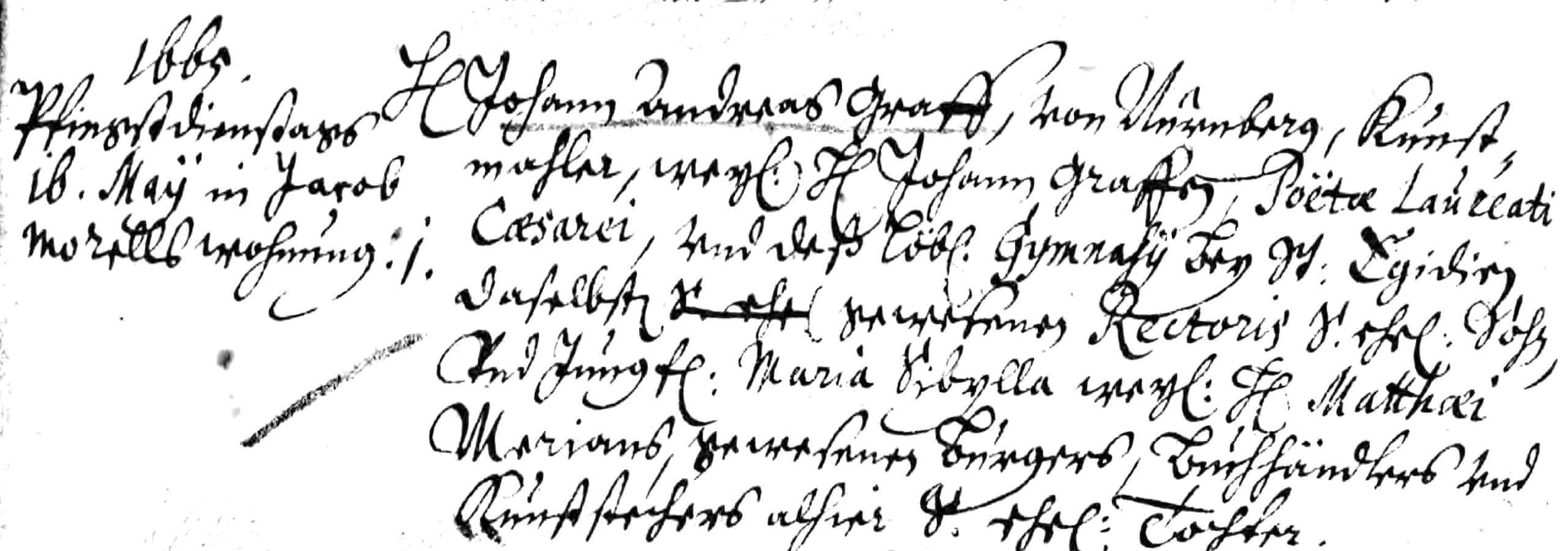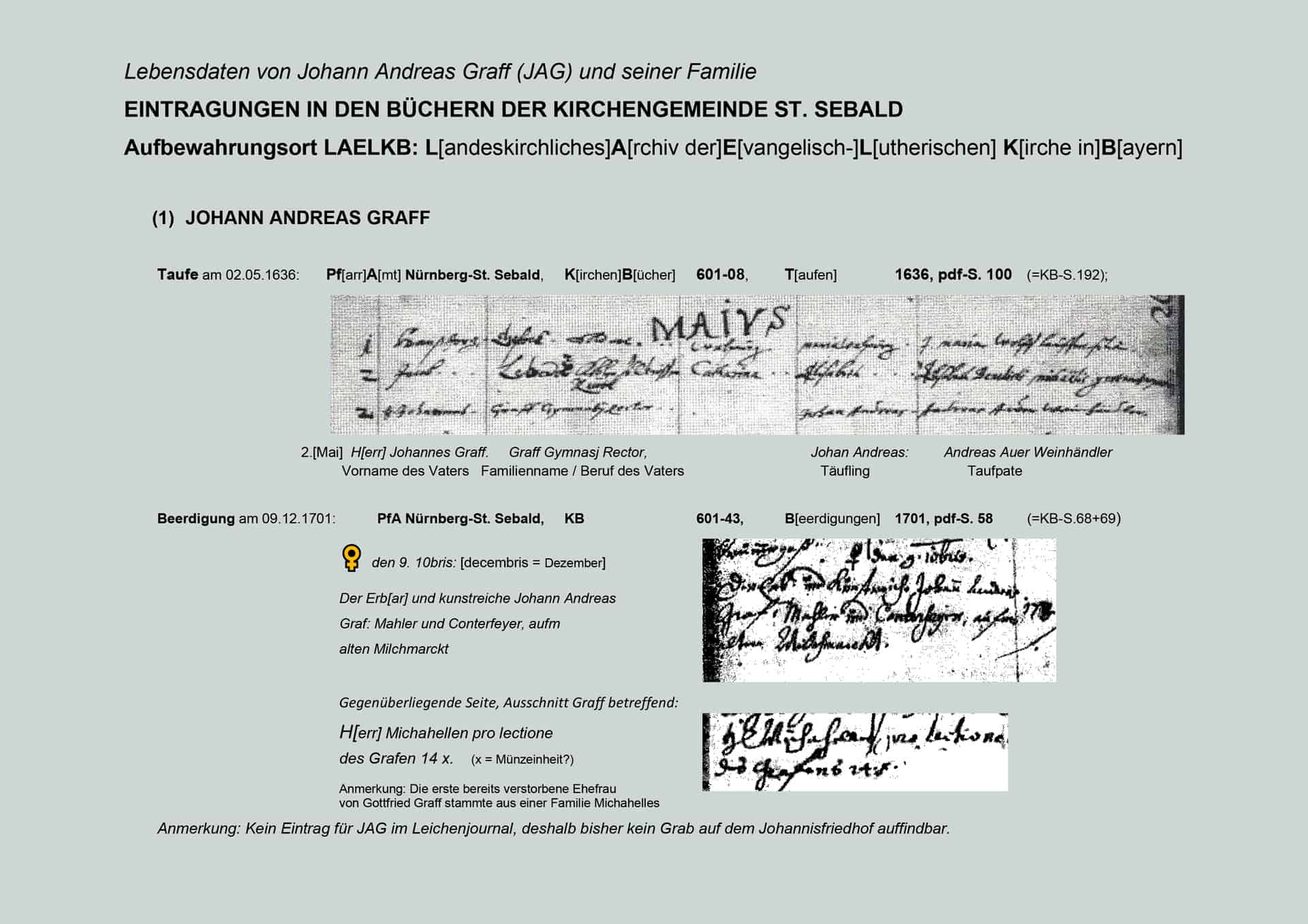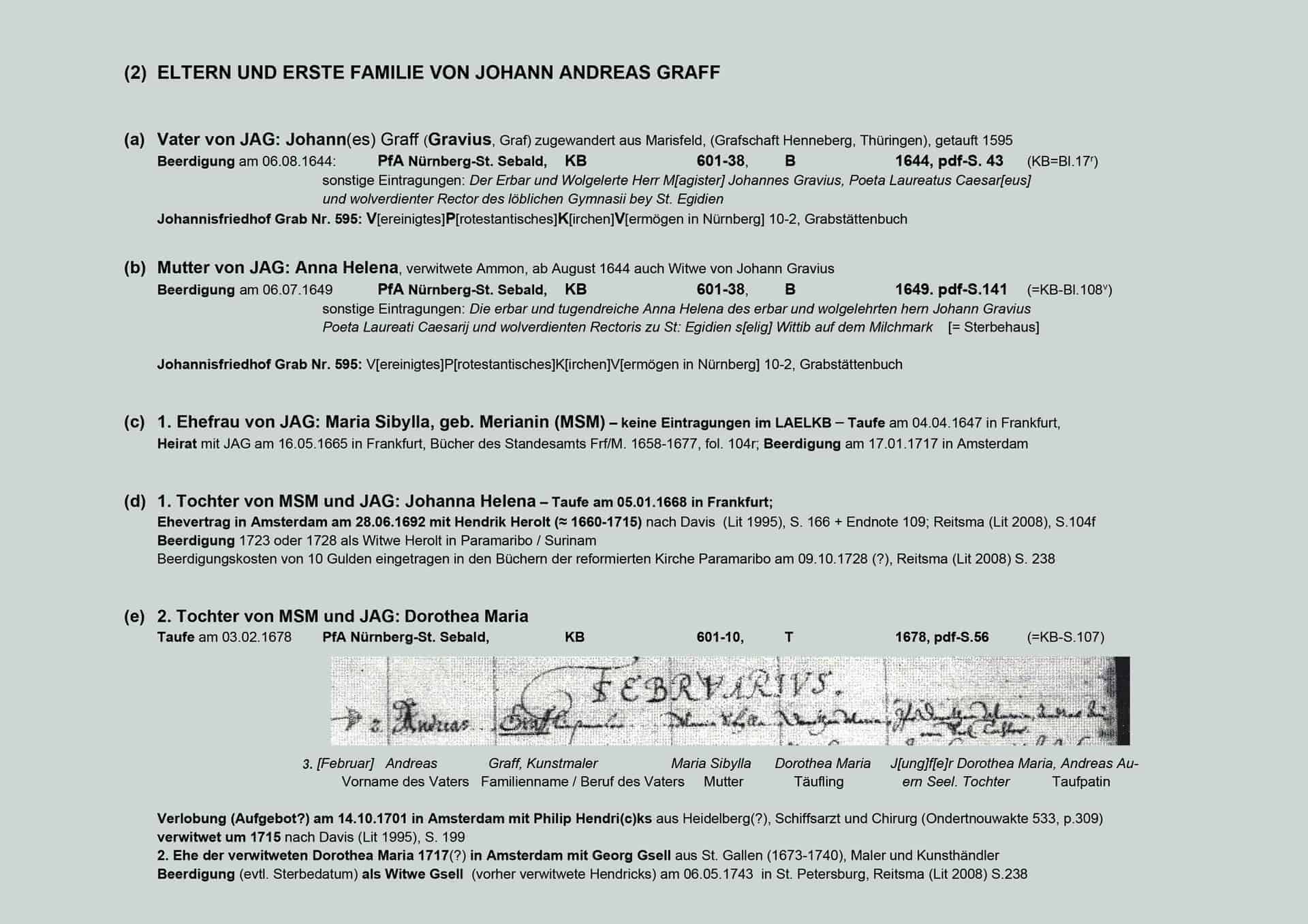TRACES IN CHURCH REGISTERS, LIBRARIES AND COLLECTIONS
Question: Who knows nowadays when exactly Maria Sibylla Merian was born? Answer: Nobody.
A) In the seventeenth century it was not the date of birth but the date of a child’s christening that was entered in church registers as the more important date. The register of christenings from the time when Maria Sibylla was born has been preserved in Frankfurt. (1) Her father Matthaeus Merian is referred to as a "bookseller” and the date of the christening is recorded as 4th April 1647. (2) At that time babies were christened a few days after the birth (often on the next day but one), so that a date of birth in early April 1647 is likely for Maria Sibylla.
The daughter of a doctor who was well-known and respected in Frankfurt at that time, Dr. med. Isaac Chombart (1612-1679), is recorded as godmother (hub means raised, i. e., the child from the christening font). This allows us to draw conclusions regarding the social position of the baby’s family. Since the sources for this early period are sparse, such evidence provides valuable clues.
In what follows, two further examples illustrate just how informative the entries in the Frankfurt records are for any detailed research into the time when Maria Sibylla Merian lived in this city. They certainly contributed to the clarification of facts in several cases described on this website.
B) The "proclamation" on 30th April 1665 of the wedding of Johann Andreas Graff with Maria Sibylla Merian (5) is similar to the reading of the banns in later eras. It is noteworthy that the wedding on 16th May 1665 did not not take place in a church, but in the private residence of Jacob Morell [Marrrell], the stepfather of Maria Sibylla and former teacher and master of Johann Andreas Graff. Another wedding even took place In his home on the same day. This points to the early Pietist orientation of the Merian-Marrell-Graff family, who did not seek their spiritual connection to God in church ceremonies, but in deep personal piety
The professional designation "Kunstmahler" is important for Johann Andreas Graff: he was a skilled artisan, not to be confused with a "simple" craftsman like a house painter or a whitewasher. Also interesting is the detailed mention of his late father as Principal of the Gymnasium von St. Egidien and Poeta Laureatus, a rare distinction for service to the cultivation of language and the art of rhetoric. (6). Graff was thus the "son of a good family".
In addition to these entries, there are two historical sources with glimpses into this wedding long before the time when memories could be preserved by wedding photos or even videos. For by a happy coincidence, two printed booklets of wedding poems have been preserved, probably because a lover of such "Gelegenheitsgedichten" (occasional poems), which were popular at the time, took his extensive collection with him when he moved from Nuremberg to Zwickau. There they were stored and catalogued in the Council School Library (Ratsschulbibiliothek). Dr. Christine Sauer, Head of the Historisch-Wissenschaftliche Stadtbibliothek Nuremberg, rediscovered them in the "VD 17" catalogue of seventeenth-century prints and hence made a first evaluation possible.
Already the title pages suggest that these booklets are unusually concrete testimonies to the situation of this artistically particularly gifted couple at the time. With these verses we can develop our own imaginary, but nevertheless vivid picture of the bride and groom. The well-wishes of those offering their congratulations are so sensitively attuned to the 31-year-old groom and the 18-year-old bride that they reflect the expectations of the bridal couple for their common future.
Title pages of two printed booklets with poems as wedding gifts from patrons and friends on the left and from the groom's brother on the right (7)
Congratulations in Detail
Predecessors of "Social Media" in the 17th Century?
C) At the christening of Johanna Helena on 5th January 1668 (8) we find - in contrast to her mother’s christening - no godmother from another Frankfurt family with whom closer, perhaps even friendly relations existed. Johanna Helena’s godmother (indicated by the verb “hub” ) was her own grandmother, Johanna Sibylla Marrell (Morell); „uxor“ is the Latin term for wife. Johanna Sibylla Marrell was the widow of Matthaeus Merian, the father of Maria Sibylla and grandfather of the infant being christened. Obviously, the young family had already planned to move to Nuremberg with the baby Johanna Helena or may even have been about to do so. For this reason, kinship was more important than the social environment in Frankfurt when the godmother was chosen.
In the 17th century there were no registry offices or offices where people had to register on moving to a town; and the most important sources for the beginning and end of life, as well as for marriages, are church records. However, in Frankfurt it was not the parishes but a municipal institution that was responsible for these entries on christening, marriage and death. There the “Almosenschreiber” (alms scribe) in the city's “Almosenkasten” (alms house) was responsible for keeping such registers. Thus at that time these books originated in a social institution for the care of the poor, a forerunner, so to speak, of today's Social Security Offices. (1)
Entries in relation to Maria Sibylla Merian in the Christening and Wedding Records of Frankfurt (1)
A) Heading for the year and the month:
„Anno 1647. Aprilis“ (2)
Entry for the date:
„Sontags d(en) 4. Aprilis“ (2)
Entry for Maria Sibylla’s christening:
4. April 1647 (alter Kalender) (4):
„Herr Matthaeus Merian, Buchhändtler, uxor Johanna
Sibylla, ein tochter Maria Sibylla, hub Jungf(rau)
Maria, Herrn Isaac Schomparts Medicinae
Doctoris tochter.“ (2)
B) Entry for the announcement date:
„1665 Dominica Rogate, 30. Aprilis 1665“ (5)
Entry for the Graff-Merian wedding with date:
Mai 1665 (alter Kalender) (4):
„1665
Pfingstdienstags
16. May in Jacob
Morells wohnung
H(err) Johann Andreas Graff, von Nürnberg, Kunst-
mahler, wey(land) H(errn) Johann Graffen, Poëtae Laureati
Caesarei v(nd) deß löb(lichen) Gymnasӳ bey St. Egidien
daselbst(en) gewesenen Rectoris S(eligen) ehe(licher) Sohn,
Vnd Jungf(rau) Maria Sibylla, weyl(and) H(errn) Matthæi
Merians, gewesenen Burgers, Buchhändlers vnd
Kunststechers alhier S(eligen) ehe(liche) Tochter.“ (5)
C) Heading for the year and the month:
„Anno 1668. Januarius“ (8)
Entry for the date:
„Sontags 5. Januarius“ (8)“
Entry for Johanna Helena‘s christening:
5. Jan. 1668 (alter Kalender) (4)
„Johann Andreas Graff, Mahler, uxor Maria Sibÿlla
ein Tochter Johanna Helena, hub Johanna Sibylla,
Jacob Morells Mahlers haußfr(au), Ihre Mutter.“ (8)
In Nuremberg, on the other hand, as in most other places in the German-speaking world, such registers were kept as church records. Fortunately, they are completely preserved here for the time of the Graff-Merianin family, while elsewhere they were, regrettably, often destroyed by warlike events over the centuries. in Nuremberg the parishes of St. Sebald and St. Lawrence were responsible, each with their own separate registers. Thus, the first thing to be established is the parish in which the people one is trying to trace lived, i.e., whether they lived on the north side of the Pegnitz (St. Sebald) or on the south side of the river (St. Lawrence).
In what follows, a few examples illustrate just how informative the entries in Nuremberg church records are for any detailed research into the time when Maria Sibylla Merian lived in this city. The places where information can be found are subsequently compiled into a list because they provide surprising insights into the lives and interwoven relationships of people in Maria Sibylla’s Nuremberg milieu. As laborious as it may be to find these handwritten entries in long, closely written lists and to study them in detail, they are among the most important - and often the only - sources for uncovering connections in this period over 300 years ago. For research on Merian’s Nuremberg family, the entries for Johann Andreas Graff and his relatives in the parish books of St. Sebald are especially important, as is shown here using six examples).
1) The christening records are interesting since they provide details of the fathers’ professions. In the entry for the christening of Johann Andreas Graff (2.5.1636) we find "Johann Graff, Gymnsj, Rector" (headmaster of a grammar school) as the father's profession. In the register of funerals the entry for the father is even augmented by a tribute: "The Honorable and Highly Learned Mr. M[agister] Johannes Gravius, Poeta Laureatus Caesar[eus] and meritorious Rector of the laudable grammar school at St. Egidien [St. Giles]".(Entry 2a) The distinction of Poeta Laureatus for his services to language and rhetoric was thus particularly worthy of mention and shows that he was a much-respected citizen of Nuremberg, even though he was an immigrant from Thuringia.
2) His son’s registered godfather was “Andreas Auer, wine merchant”, an immigrant from Vienna, who certainly became important in Johann Andreas’s life after the latter’s father died when he was only eight years old.
3) Friendly relations between the Auer and Graff families existed for decades. On 2th February 1678 a daughter of the wine merchant became the godmother of the Graffs’ younger daughter, who was named Dorothea Maria after her godmother (entry 2e).
Maria Sibylla received lessons in painting from Johann Paul Auer, a brother of Dorothea Maria Auer and one of the directors of the newly established academy of painting. (9) In October 1702 (i.e., after her return from Surinam) Maria Sibylla was still asking her correspondent Johann Georg Volkamer the Younger (10) "to pass on my very best wishes ... to my dear godmother Auer". (12) She adds that she would really prefer to get together with her in person because she had a lot to tell her.
4) When the mother of Johann Andreas Graff died (1649), she was registered in the register of funerals as "Wittib auf dem Milchmark" [widow on the Milk Market] (entry 2b). When her son died more than fifty years later (1701), the address in this register is also "aufm alten Milchmarckt" [on the old Milk Market]. (entry 1). This refers to the area beyond the Albrecht Dürer monument, which was erected much later. This indication is important at a time when street names were not yet clearly fixed and house numbers had not yet been introduced. This localization is - in addition to the preserved title deeds - an evidence of the longstanding family ownership of the handsome dwelling "Zur Guldenen Sonne". This refers to the area above the Albrecht Dürer monument, which was erected much later. In addition, the entry even contains an address, namely "on the Old Milk Market" (i.e., today up the hill and beyond the Albrecht Dürer monument).
5) Johann Andreas Graff’s sons from his second marriage (entry 3b and 3c) were given godfathers from the Nuremberg upper class. (11) Nuremberg was a hierarchical society at that time and Graff belonged to the lower class of craftsmen, despite the high quality of his artistic work. But Nuremberg was also a civic city, where education and professional achievement could foster many social contacts between different social levels.
6) The lifetime work of Johann Andreas Graff was appreciated in the funeral register on 9th December 1701 (entry 1) by being described as "The “Erbar und kunstreiche” Johann Andreas Graf: painter and portrait painter on the Old Milk Market ". These words “honourable and highly skilled” (?) express an appreciation for him and his professional activities.
ENTRIES IN THE REGISTERS OF THE PARISH OF ST. SEBALD
ARCHIVE LOCATION LAELKB: L(andeskirchliches) A(rchiv der) E(vangelisch-)L(utherischen) K(irche in) B(ayern)
In 1700 the Gregorian calendar was introduced into Frankfurt and Nuremberg. Until then the Julian calendar had been used, in which the calendar year was, however, slightly longer than the solar year. Due to the increasing drift over the centuries, 10 days were removed from the calendar and the leap days were reorganised so that in the future the calendar year and the solar year would correspond better. This is why, for example, 10 days have to be added to Maria Sibylla Merian's baptism date for it to correspond to today's calendar: 14th April instead of 4th April 1647.















